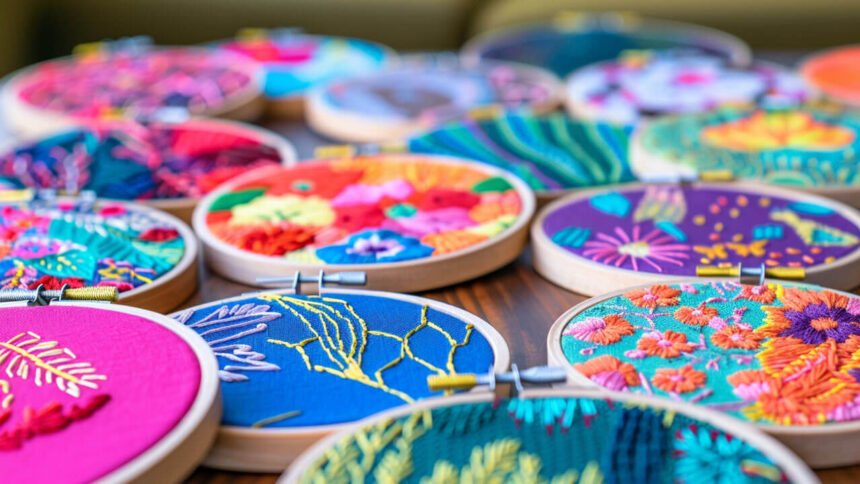Custom embroidery is more than just a decoration technique—it’s an intricate process that transforms creative ideas into vibrant, tactile designs. Whether it’s a corporate logo, a personalized gift, or a team emblem, embroidery provides a durable, professional, and elegant way to showcase individuality and brand identity.
This article takes you behind the scenes of the custom embroidery process, from the initial concept to the final stitch, highlighting the artistry, technology, and expertise involved.
The Journey of Custom Embroidery: Step by Step
1. Conceptualizing the Design
The first step in custom embroidery is developing a clear concept for the design.
- Collaboration: Customers work with embroidery providers to refine their ideas, ensuring the design meets their vision and practical needs.
- Design Details: Considerations include size, color palette, and placement on the garment.
2. Digitizing the Design
Digitizing converts the design into a format readable by embroidery machines.
- Precision Planning: This process involves mapping out every stitch, thread color, and density to ensure accuracy and consistency.
- Specialized Software: Advanced software creates a digital file that guides the embroidery machine during production.
3. Choosing the Right Materials
The type of fabric and thread used can significantly impact the final result.
- Fabric Compatibility: Durable fabrics like cotton, polyester, and denim are ideal for embroidery.
- Thread Selection: High-quality threads in a variety of colors ensure vibrant, long-lasting designs.
4. Machine Setup
Embroidery machines are prepared with the necessary threads, needles, and stabilizers based on the fabric and design.
- Stabilizers: These materials prevent fabric distortion during stitching, ensuring a clean finish.
5. Embroidery Execution
The embroidery machine brings the design to life, stitch by stitch.
- Consistency: Modern machines deliver precise and uniform results, even for complex patterns.
- Layering: Multi-layered designs are built up gradually, creating depth and texture.
6. Finishing Touches
Once the embroidery is complete, the garment is trimmed, pressed, and inspected for quality assurance.
The Art and Science of Embroidery Digitizing
Digitizing is a crucial part of the embroidery process, combining artistic creativity with technical expertise.
1. Understanding the Design
- Each design is analyzed to determine how it will translate into stitches. Factors like size, detail, and complexity are considered.
2. Creating Stitch Types
- Fill Stitches: Used for large areas, providing coverage and texture.
- Satin Stitches: Ideal for borders and lettering, offering a smooth, polished look.
- Running Stitches: Used for outlines or fine details.
3. Optimizing for Fabric
- Different fabrics require tailored approaches to prevent puckering, distortion, or thread breakage.
4. Balancing Density
- Proper thread density ensures the design is neither too heavy nor too sparse, maintaining both durability and aesthetic appeal.
Applications of Custom Embroidery
Custom embroidery is versatile, with applications ranging from personal use to professional branding:
1. Corporate Branding
- Embroidered logos on uniforms, hats, and jackets create a cohesive and professional look for businesses.
- Quality embroidered apparel helps businesses stand out in competitive markets.
2. Team Spirit
- Sports teams, clubs, and organizations use embroidery to showcase pride and unity.
- Durable stitching ensures team logos and names last through rigorous activity.
3. Fashion and Retail
- Embroidery adds a touch of sophistication and uniqueness to clothing and accessories.
- Popular in both high-end and streetwear fashion, it blends traditional craftsmanship with modern design.
4. Personalized Gifts
- Monograms, names, or custom designs make everyday items like towels, aprons, and tote bags special and memorable.
The Benefits of Custom Embroidery
1. Durability
- Embroidered designs are long-lasting, withstanding washing, wear, and exposure to the elements.
2. Timeless Appeal
- The textured, professional look of embroidery is universally appreciated and never goes out of style.
3. Customization
- From bold logos to delicate patterns, embroidery can be tailored to suit any aesthetic or purpose.
4. Eco-Friendly Options
- Many embroidery threads and fabrics are made from sustainable materials, making embroidery an environmentally conscious choice.
Challenges in Embroidery and How Professionals Overcome Them
1. Fabric Puckering
- Stabilizers and careful tension adjustments prevent distortion during stitching.
2. Complex Designs
- Digitizing simplifies intricate designs, ensuring even the most detailed patterns can be embroidered.
3. Thread Breakage
- High-quality threads and properly maintained machines minimize interruptions and ensure smooth production.
4. Color Matching
- A wide range of thread colors ensures accurate reproduction of brand logos or specific design palettes.
Providers like ThreadCo use advanced techniques and equipment to deliver flawless embroidery, addressing these challenges with expertise.
Embracing Innovation in Custom Embroidery
Technology continues to push the boundaries of what’s possible in embroidery:
1. 3D Puff Embroidery
- Adds depth and texture to designs, making logos and text pop.
2. Glow-in-the-Dark Threads
- Perfect for creating standout designs for nighttime events or safety apparel.
3. Mixed Media
- Combining embroidery with screen printing or applique creates unique, multi-dimensional designs.
4. Sustainability
- The use of biodegradable threads and eco-friendly processes aligns embroidery with modern environmental values.
Tips for Designing Custom Embroidery
1. Keep It Simple
- Clean, bold designs translate best into embroidery, especially for logos or text.
2. Consider Placement
- Choose locations that complement the garment’s structure, such as the chest, sleeve, or back.
3. Test the Fabric
- Ensure the chosen fabric can support the design without stretching or puckering.
4. Work with Experts
- Professional embroidery providers guide you through the design and production process, ensuring top-quality results.
Final Thoughts
Custom embroidery transforms ideas into tangible, lasting designs that combine artistry and functionality. From the initial concept to the final product, the process showcases precision, creativity, and craftsmanship.
Whether for corporate branding, personal expression, or fashion-forward designs, custom embroidery offers endless possibilities to make a statement. With trusted providers like ThreadCo Print, achieving high-quality embroidered apparel is a seamless and rewarding experience.


